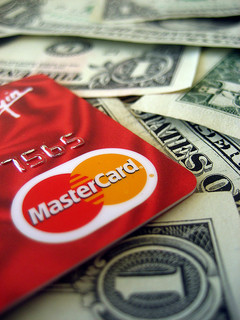If the past few Money Mondays posts have taught you anything, it should be that life presents us with a number of fairly necessary expenses. Many individuals utilize a credit card to cover some of their expenses. Credit cards are not inherently bad, but you have to understand how they work and how they ought to be used.
There are a variety of credit card types around. If you’ve ever made a purchase at a retail store like Gap, you’ve probably been asked if you have a Gap Card. This kind of card can often only be used at a specific store. There are also secured credit cards. You make a money deposit to the card issuer, and this deposit serves as collateral and the source for your credit. These cards are ideal for individuals with no credit or bad credit. Finally, there are unsecured credit cards, which are the most common. Your credit score largely determines the credit limit for unsecured cards.
You might be wondering just what a credit score is. Your credit score lets lenders (like car dealers and banks) know how likely it is that you will repay your debts. Fair Isaac’s Corporation is the most common credit scoring system, often referred to as FICO. A FICO score considers several things:

- Payment History – Have you consistently paid bills on time? This is the largest component of your credit score.
- Amount Owed – How much debt do you have?
- Length of Credit History – How long have you had credit accounts, including loans? The longer the better.
- New Credit – Have you opened up several new lines of credit in a short period of time? This may decrease your score.
- Types of Credit Used – What kinds of credit accounts do you have? Credit cards, car loans, student loans? Having several kinds of credit can be a good thing, as long as you pay your bills on time.
After factoring in each of these items, your score is determined. Credit scores fall between 300 and 850; the higher the number, the better the score. As mentioned above, lenders often use your credit score to determine your credit card limit. When you receive a credit card, it means that a bank or credit union has given you the ability to borrow a given amount of money. They want to know you will be able to repay that money.
One thing that can improve your credit score after you have received your credit card is keeping your credit card balance low. Many individuals suggest spending less than 30% of your credit limit. This means if your limit is $5,000, you should never have a balance of more than $1,500. It can be tempting to spend up to your limit, so it is important to remember that your card doesn’t give you free money. Everything you spend is loaned to you with the expectation that you will pay it back. Once again, you need to revisit your budget and determine how much you can afford to spend.
When you receive your credit card bill each month, consider paying as much as you can rather than just paying the minimum amount. Ideally, you should try to pay off the balance of your card each month. Credit card interest rates are much higher than other loans, ranging anywhere between 6% and 20% (sometimes more!). If you have an interest rate of 20% and a balance of $200 at the end of the month, you’ll pay $40 in interest. That’s almost a full tank of gas. According to the US Census Bureau, the median household credit card debt was around $3,500 in 2011. That 20% can add up really quickly. You can see why managing your credit is so important. If you use a credit card wisely, though, it can be helpful in increasing your credit score. This will make lenders more likely to loan you money, which will become important when you want to buy a car or a house. Below are a few resources that give more information on credit cards and credit scores so you can charge responsibly!
In Andersen Library:
- Borrow: The American Way of Debt, Louis Hyman. Call Number: HG3756.U54 H95 2012, Main Collection
- Credit Card Nation: The Consequences of America’s Addiction to Credit, by Robert D. Manning. Call Number: HG3755.8.U6 M36 2000, Main Collection
Other Resources:
- Credit Cards, from the Federal Reserve
- Understanding Credit Card Interest, by Investopedia
- Understanding Credit Cards, by the American Financial Services Association Education Foundation
Note: This blog post is for informational purposes only. No content should be construed as financial advice.
